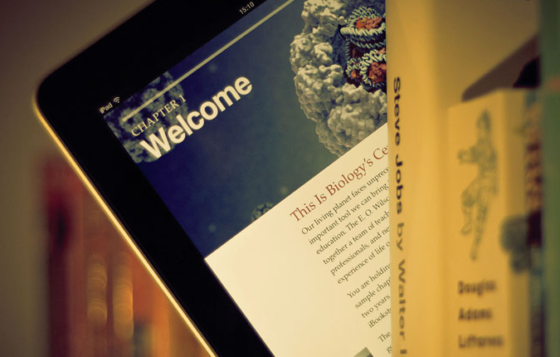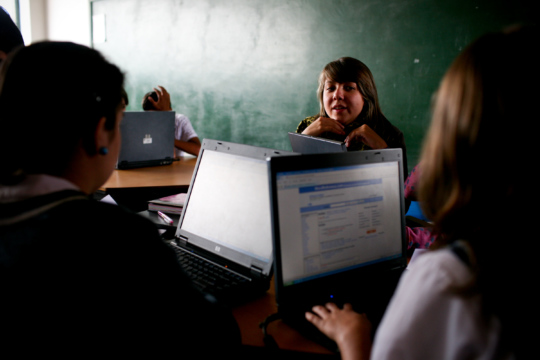
Role of E-Learning in Higher Education in Latin America
E-learning offers a new way of designing and implementing higher education in Latin America. What are its possibilities?
This post is also available in: Spanish
Latin America is one of the most proactive regions in the world when it comes to integrating new technologies into education policies. However, the majority of programs in the region have focused almost exclusively on the provision of laptops in schools through one-to-one policies that have thus far produced disappointing results and limited learning improvements. These results make it difficult to justify the high amount of time, effort, and resources that have been invested thus far. This does not imply that the use of information technology in education is a failure, but rather can be seen as an invitation to reconsider which policy options are available and seek new alternatives that may give better returns.
Mobile learning focuses on using mobile devices (cellphones, tablets, etc.) to create a ubiquitous learning experience. Technology’s portability facilitates learning opportunities, which are no longer tied to the classroom, but rather can occur at any time or place. The use of mobile phones for learning, which is the main focus of this blog, is only one of many categories within mobile learning.
Mobile learning with cellular phones has high potential in Latin America. A recent study by the World Bank revealed that 87% of Latin Americans own a mobile phone. The availability of mobile bandwidth has also increased considerably in the last few years. It is estimated that by 2020, smartphones will represent 68% of total network connections, and that 76% of the population will have mobile bandwidth available. The fast proliferation and daily use of mobile phones make it a tool that will have low adoption barriers and will be easy to integrate.
Mobile phone devices can help improve education in a variety of ways, both directly and indirectly. In particular, they can help with literacy, academic reinforcement, teaching management, educational systems administration, and learning assessments.
Literacy: The availability of phones in rural areas with low accessibility makes it an ideal device to use when trying to facilitate learning with the use of technologies. In Colombia for example, the National Literacy Program uses mobile phones as a learning platform. The government hands out phones with a special SIM card that contains self-paced learning modules. The purpose is to improve basic literacy skills. This project is especially accessible as it does not require a mobile bandwidth connection and can be used by anyone who receives the mobile device.
Academic Reinforcement: Through the development of applications and programs, phones can also be used to reinforce academic material being learnt in class. This is one of the most widely used functions of mobile learning, as there are thousands of educational applications for smartphones across the world. The launch of the smartphone application “Educando” by the Dominican Republic’s Ministry of Education is an example of this type of project being carried out at a large scale. This application serves as a review tool for students currently preparing for the national exams.
Teacher Management and Training: “Somos Docentes” (We are Teachers), a new initiative by Peru’s Ministry of Education, shows how mobile phones can also be used as a tool to support teaching staff. This is a new instant messaging program that any teacher can sign up to for free, and then receive information and updates from the Ministry of Education regarding educational themes, best practices, and pedagogical advice. Similarly to the National Literacy Program in Colombia, this project does not require mobile bandwidth, making it widely accessible across the country.
Education Systems Administration: Cellphones can also help fulfill administrative educational tasks. Through cellphones, one can facilitate communication, coordination, and availability of information, especially in rural areas. This happened in Mendoza, Argentina, where many schools have limited access to computers and internet, making school system supervision and data collection particularly difficult. As a solution, in 2010, the state government began distributing smartphones with unlimited data and minutes to school supervisors, so that they could use this new tool to record information and monitor school progress. This was possible due to the vast availability of mobile bandwidth in this region.
Assessments: Mobile phones can also be used as a new platform for collecting mobile assessments, helping increase system efficiency and reduce associated costs considerably. For example, in Paraguay, the government recently launched the Learning Assessment Through Phones Program. Through this initiative, students across the whole country were texted multiple choice questions relevant to the national curriculum. Their responses were directly recorded on to a database, which helped save significant amounts of time, money, and human capital.
Lack of assessments and evidence: Mobile learning initiatives in the region are mostly limited in scale and sporadic. In particular, there is a lack of evaluations and follow-ups, which means that there are limited results or evidence regarding how these technological initiatives may be helping (or not) to improve learning outcomes. The failure of 1:1 laptop provision programs, particularly in countries that invested large sums of money, demonstrate the perils of overvaluing or overgrowing projects that lack proper evaluation and assessments. Similarly, the fact that there has already been a large amount of time and money invested in these laptop provision projects could also detract certain governments from wanting to get involved in new technology-assisted learning initiatives as they may feel as if they have already completed this “quota” in their education policies.
Mobile bandwidth affordability: Availability of mobile bandwidth does not necessarily translate into affordability. Although the costs of mobile bandwidth have diminished in the region, amounting to only 3,84 percent of GDP per capita in 2014, this number is still significantly higher than the average costs in developed countries, where mobile bandwidth costs amount to 0,1 percent of GDP per capita. It is also important to consider the high levels of inequality that persist in the region, and how income inequality may affect affordability. A 2016 report reveals that for the poorest 40% of Latin Americans, mobile property represents 17% of their income, whereas for the wealthiest 20%, it only represents 2% of their income.
Lack of digital literacy: Many smartphone users lack the skills to fully understand and take advantage of the benefits of the internet and mobile technology. In order to incorporate mobile learning in Latin America, it is essential to assure that there are certain minimum levels of digital literacy, especially among faculty. A study published in 2012 reveals that there is a positive correlation between digital literacy and internet access; thus, digital literacy is a dual challenge as it also demands bandwidth accessibility. The lack of technological infrastructure also limits many mobile phone users, inhibiting them from maximizing the potential benefits of internet access.
Incorporate technology into pedagogy: One of the main lessons from the One Laptop per Child (OLPC) project in Peru was that technology cannot replace a good teacher or pedagogy. This also applies to m-learning. Mobile technology can facilitate learning, allowing it to occur ubiquitously, but it must work as a complement to formal education and to the role of the teacher. As such, it is recommended to incorporate mobile devices as tools that will aid a larger curriculum. In order to maximize the potential benefits of mobile learning, teacher training on the use of these technologies and best practices on how to incorporate them inside and outside the classroom is critical.
State involvement: Thus far the majority of advances in mobile learning in the region have been initiated by the private sector. Public sector participation and inter-sectoral cooperation are critical for successful large-scale mobile learning initiatives. Alliances can be built between the government, the private sector firms, academic institutions, non-governmental organizations, and/or telecommunication companies.
Creating relevant content: A current challenge that can also be taken as a unique development opportunity is the lack of relevant digital content for Latin America. This is primarily due to the fact that the majority of online material currently available is in other languages (primarily English), or is directed to populations in other regions of the world. As such, within the process of technology provision, it is also imperative to make sure that adequate, relevant, and effective contents are being developed for the audiences that will be exposed to mobile learning.
Ashley Manning is a Summer Intern with the Education Program at the Inter-American Dialogue.
Federico Sucre is a Program Associate with the Education Program at the Inter-American Dialogue. Contact: fsucre@thedialogue.org. Twitter: @FedeSucre.
E-learning offers a new way of designing and implementing higher education in Latin America. What are its possibilities?
This post is also available in: SpanishLeer en español The use of technology in education has the potential to improve the teaching and learning experience both inside and outside the classroom. All over the world we are increasingly seeing successful technology-driven innovations. Whether reaching children and young people…
